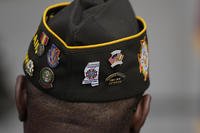The U.S. Navy's F-35C Joint Strike Fighter is officially combat ready.
Vice Adm. DeWolfe Miller III, commander of Naval Air Forces, and Lt. Gen. Steven Rudder, Marine Corps deputy commandant for aviation, declared Thursday that the Lightning II aircraft carrier variant has "met all requirements" to achieve initial operational capability (IOC), the Navy said in a release.
"The F-35C is ready for operations, ready for combat and ready to win," Miller said in the statement. "We are adding an incredible weapon system into the arsenal of our Carrier Strike Groups that significantly enhances the capability of the joint force."
As the last of the three U.S. services that fly the aircraft to declare its combat-ready status, the Navy has been working to make its expected February 2019 timeline.
Related content:
- Marine F-35s Dropped a Bunch of Bombs on ISIS During 1st Middle East Deployment
- Combat Debut: Marines' F-35B Strikes Taliban Target in Afghanistan
- F-35A Ready for Action in the Pacific if Necessary, SecAF Says
To reach the milestone, the first operational squadron had to be "properly manned, trained and equipped to conduct assigned missions in support of fleet operations," officials said Thursday.
"This includes having 10 Block 3F, F-35C aircraft, requisite spare parts, support equipment, tools, technical publications, training programs and a functional Autonomic Logistic Information System (ALIS)," the release states, referring to the latest software variant and software and sustainment system.
The Defense Department's F-35 Joint Program Office is overseeing efforts to move to the even more advanced Block 4 software, which would give the F-35 an enhanced sensor range and a larger weapons suite sometime in the early 2020s.
In December, the Strike Fighter Squadron (VFA) 147 "Argonauts" out of Naval Air Station Lemoore, California, completed a critical milestone aboard the aircraft carrier Carl Vinson, a turning point in reaching IOC with a "safe for flight" operation certification.
Officials said declaring IOC was predicated upon the Vinson being equipped with "proper infrastructure, qualifications and certifications."
The Argonauts are slated to become the service's first operational F-35C squadron. VFA-147's first deployment is scheduled aboard the Vinson in 2021.
In 2013, the Joint Program Office detailed in a report to Congress when each variant would reach IOC.
The "Navy F-35C IOC shall be declared when the first operational squadron is equipped with 10 aircraft, and Navy personnel are trained, manned and equipped to conduct assigned missions," the report stated. "Based on the current F-35 JPO schedule, the F-35C will reach the IOC milestone between August 2018 (Objective) and February 2019 (Threshold)."
The Navy reached its goal on the last day of the month.
"We congratulate the Department of the Navy on achieving Initial Operational Capability with its fleet of F-35Cs," said Greg Ulmer, Lockheed Martin vice president and general manager of the F-35 program, in a statement. "As we celebrate this achievement demonstrating the progress of the F-35 program, we're also setting our sights forward to ensure the U.S. Navy is ready for its first F-35C deployment."
The Marine Corps was the first service to reach IOC, declaring its F-35B short take-off and vertical landing variant ready for combat in 2015.
The Air Force's F-35A reached the milestone in 2016.
The F-35 made its combat debut in the Middle East when Israel's variant conducted strikes in 2018. That September, the Marine Corps' F-35B had its first combat outing, conducting its first strike in Afghanistan against the Taliban.
The Navy's milestone comes as it plans to deactivate its F-35 squadron at Eglin Air Force Base, Florida, and move operations to NAS Lemoore, concentrating its Joint Strike Fighter operations on the West Coast.
-- Oriana Pawlyk can be reached at oriana.pawlyk@military.com. Follow her on Twitter at @Oriana0214.










